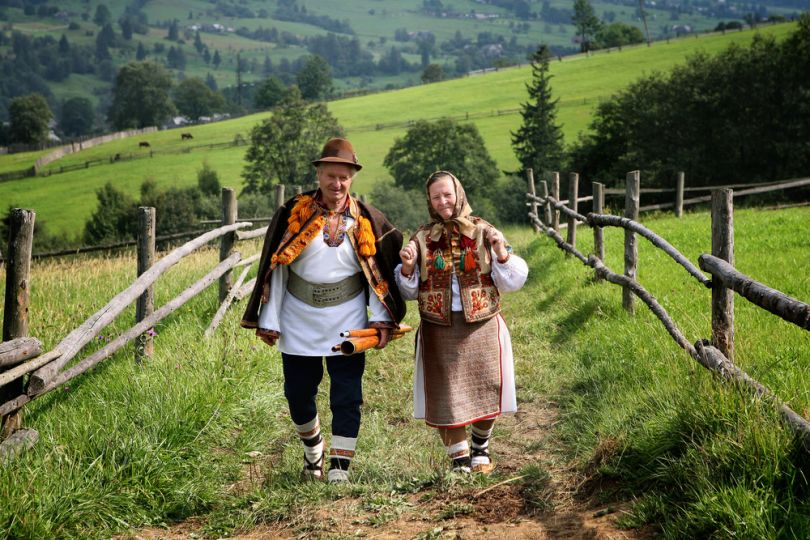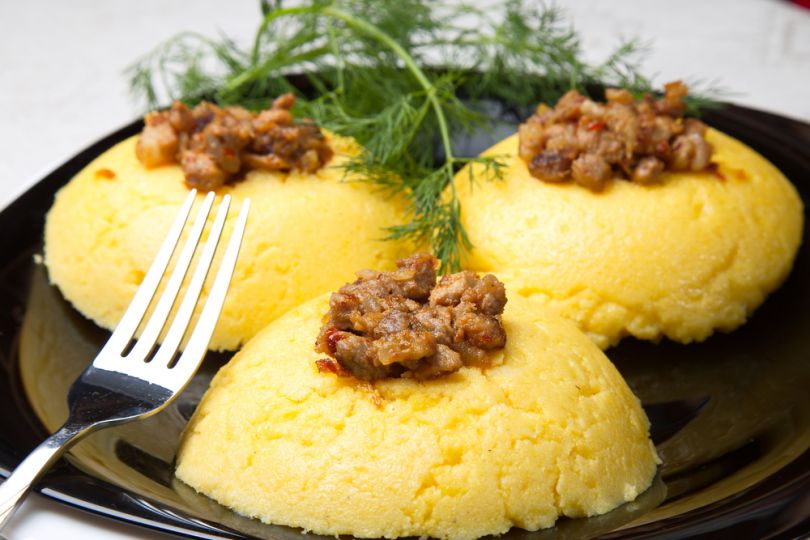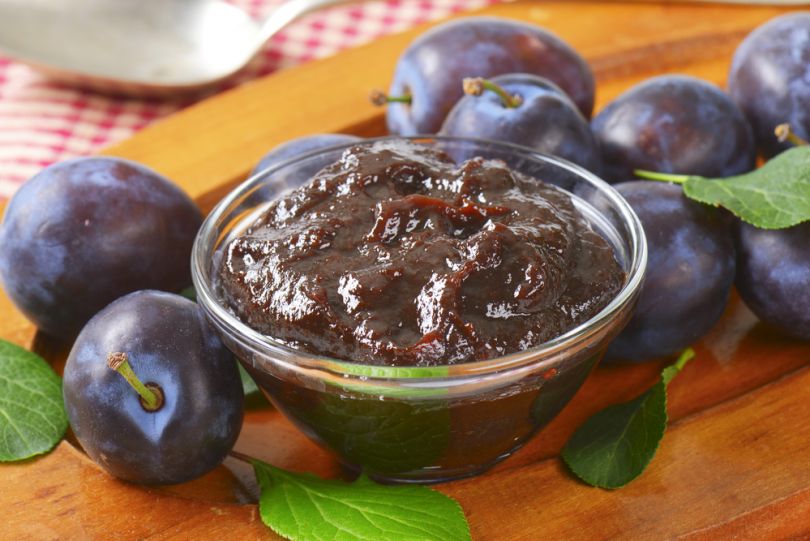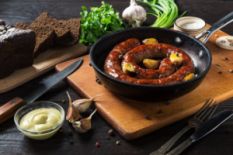History
 The highlands of the Carpathian Mountains have a rich history and are home to different nationalities and ethnic groups that managed to leave in peace throughout centuries. As the region borders no less than 4 countries - Romania, Slovakia, Hungary, and Moldova - the local cuisine brings together the best flavors of each cuisine.
The highlands of the Carpathian Mountains have a rich history and are home to different nationalities and ethnic groups that managed to leave in peace throughout centuries. As the region borders no less than 4 countries - Romania, Slovakia, Hungary, and Moldova - the local cuisine brings together the best flavors of each cuisine.
For Hutsuls and Boikos, the most populous ethnic groups of Ukrainian Carpathians, a meal is not just a way to tame hunger but also to communicate. Sharing a meal is still considered an important social gathering and carries more importance than in urban areas of central Ukraine. The region’s classic dishes are traditionally prepared in large pots on the open flame or in the oven.
As for the most popular products, corn flour and brynza cheese are definitely the leaders in the Carpathians. Fresh mushrooms find their way in any hot dish as well as traditional salo, most often served as pork lard. As for the desserts, Ukrainian Carpathians are famous for honey making and making unique local jams called lekvar.
Mamalyga
 One of the most iconic Carpathian dishes, mamalyga, originally comes from Romanian cuisine. The porridge is made of yellow maize flour and is traditionally served with sour cream and brynza. The Hutsul dish has a special feature that should be noted: after it's cooked, you have to place it on a wooden board or a fresh towel instead of a plate so that mamalyga keeps its original flavor. The dish often replaces bread.
One of the most iconic Carpathian dishes, mamalyga, originally comes from Romanian cuisine. The porridge is made of yellow maize flour and is traditionally served with sour cream and brynza. The Hutsul dish has a special feature that should be noted: after it's cooked, you have to place it on a wooden board or a fresh towel instead of a plate so that mamalyga keeps its original flavor. The dish often replaces bread.
Ingredients:
- 2 cups of corn flour
- 6 glasses of water
- brynza cheese
- 100 grams of smoked salo and pork rinds
- salt hard
- cheese
- fried onions
Preparation:
- Fry the corn flour on a dry skillet until an even golden color and a pleasant smell of fried corn.
- Take a large pot. Add water, salt, 4 tablespoons of flour and bring to a boil. Sieve the rest of flour into the boiling water. Stir continuously with a wooden spoon and press the flour to the walls for the pot. Cook for 25-30 minutes.
- Reduce the heat and boil for 10-15 more minutes while stirring continuously until the mass thickens. To tell if mamalyga is ready, take a wooden roller or a wooden spoon and lower it in a pot. If the mass doesn't stick to the wooden utensil, mamalyga is ready.
- Using a wet spoon and spatula, separate mamalyga from the pot walls. Put on a wooden board or a towel. Note: don't put mamalyga on a plate, as it will become too dry and lose its flavor. Cut the dish with a thick thread.
- Put bryza, sour cream, pork rind and fried onions in separate plates. You can add ingredients to mamalyga up to your taste.
Bograch
 Bograch or bogrács is a traditional Hungarian soup that made its way in the Carpathian cuisine. It is made from pork lard, meat and vegetables like carrots. The soup has a tingly flavor thanks to the spices and ground sweet pepper the cooks usually add into the dish.
Bograch or bogrács is a traditional Hungarian soup that made its way in the Carpathian cuisine. It is made from pork lard, meat and vegetables like carrots. The soup has a tingly flavor thanks to the spices and ground sweet pepper the cooks usually add into the dish.
Ingredients:
- 3 kg of meat (ribs, pulp, neck and hooves)
- 150 g of smoked salo
- 200 g of onions
- 300 g of carrots
- 200 g of parsley
- 1 Kohlrabi (about 10 cm in diameter)
- 1 kg of potatoes
- 2 tablespoons of ground red pepper
- 1-2 pc. black ground pepper
- 1 pod of bitter pepper
- 1-2 lavender leaves
- a bunch of green parsley
Preparation:
- Take a pot and put it on a medium flame. Wait until it warms up. Cut the smoked salo into thin pieces, fry until it becomes pink. Take it out with a wooden spoon, place on a separate plate.
- Finely cut the onions, add grease or oil into the pot and fry. Add a small amount of water and let the onions cool down. At once add red ground pepper, mix and throw in meat cut into cubes and chopped hooves.
- Mix thoroughly; add a small amount of water in a few minutes. The meat should be stewed, not boiled. Then add salt, ground black pepper, 1-2 lavender leaves. Gradually add water enough for the bograch to cook. The mass should resemble goulash, not a soup.
Banosh
 Banosh, also known as Banusz, is the principal dish of Hutsul cuisine. The ethnical group that lives in the Carpathians has their own way of cooking banosh - in an oven opposed to the urban stove. The dish is quite dense, but not as dense as tokan and has a slightly sour taste. Banosh is served hot with sour cream, brynza cheese or pork lard.
Banosh, also known as Banusz, is the principal dish of Hutsul cuisine. The ethnical group that lives in the Carpathians has their own way of cooking banosh - in an oven opposed to the urban stove. The dish is quite dense, but not as dense as tokan and has a slightly sour taste. Banosh is served hot with sour cream, brynza cheese or pork lard.
Ingredients for two portions:
- 500 ml of cream (or sour cream, although in this case, porridge can get sour)
- 200 g of corn groats a pinch of salt
- brynza cheese
- salo
Preparation:
- Pour the cream into a pot or a thick pan, put on a medium fire and bring to a boil.
- Little by little, add the corn groats, stirring constantly with a wooden spoon.
- Reduce the fire to a minimum, add a pinch of salt and cook, stirring, until the groats become almost soft. At this stage you might need to add some more cream - the porridge should remain a consistency of dense sour cream.
- Whip the porridge intensely until oil appears on the surface. Remove from the heat, lay it on a shallow plate.
- Slice salo and make the pork rind. Put on top of a banosh. Cut brynza cheese in small cubes and add into the porridge.
Apart from salo and brynza, various kinds of mushrooms, fried onions can also be added to banosh. Sometimes cooks use flour instead of corn grain - then the porridge is prepared way faster.
Tokan with brynza cheese à la Khust
 Tokan is the classic dish of Khust district shepherds. The recipe hasn't changed for centuries and varies only from region to region. While some restaurants and chefs state that tokan and banosh are the same, there's one principal difference respected by the Carpathian locals: tokan is much thicker than banosh and is cooked on water.
Tokan is the classic dish of Khust district shepherds. The recipe hasn't changed for centuries and varies only from region to region. While some restaurants and chefs state that tokan and banosh are the same, there's one principal difference respected by the Carpathian locals: tokan is much thicker than banosh and is cooked on water.
Ingredients:
- 2 cups of corn flour
- 6 glasses of water
- 200 g traditional Khust brynza
- 80 g of smoked salo salt
Preparation:
- Take a large bowl. Pour water, add salt and 4 tablespoons of corn flour and bring to a boil. After that, very slowly and in small amounts add the remaining flour. Slowly stir the mixture with a wooden spoon.
- Render the salo. To do this, cut salo into pieces, put in a pot, pour in water and cooked for an hour or two on a small fire without removing the lid. After that, the rendered salo is chilled and cooled.
- Take a wide bowl. Grease it with the grease from rendered salo.
- Put a 2-cm layer of tokan porridge in a bowl. Sprinkle with bryza. Layer until you run out of porridge. You can also sprinkle the dish with greens.
Lekvar
 Lekvar is a traditional Carpathian jam known for its incredibly dense structure. It is reached by long boiling period - the whole day and often the whole night. Traditionally, lekvar is made in copper cauldrons on an open flame until the mass gains a dark blue, almost black color. It is believed to have a beneficial effect in the treatment of colds. You can try the real lekvar in Botar village in Transcarpathia, in the first Lekvar Museum opened by Pavlo Tizesh. The degustation tour includes more than 10 types of the traditional Carpathian jam.
Lekvar is a traditional Carpathian jam known for its incredibly dense structure. It is reached by long boiling period - the whole day and often the whole night. Traditionally, lekvar is made in copper cauldrons on an open flame until the mass gains a dark blue, almost black color. It is believed to have a beneficial effect in the treatment of colds. You can try the real lekvar in Botar village in Transcarpathia, in the first Lekvar Museum opened by Pavlo Tizesh. The degustation tour includes more than 10 types of the traditional Carpathian jam.
Ingredients:
- 2 kg of plums (Zwetschge kind suits the best)
Preparation:
- Wash plums, cut into halves, remove the pits.
- Place plums in a pot or casserole and put on high heat for about 5 minutes.
- Put a lid on the pot, lower the heat and boil the jam for about 10-11 hours. Once the jam is dense, thick and doesn't slip off a spoon, it's ready.
Store in a cold place without access to sunlight. Lekvar works well as a stuffing for pies as well as a spicy sauce for meat.
Where to try authentic Carpathian products
Luckily, going deep in the Carpathians isn't always necessary to try the regional products and dishes. In fact, tourists have a chance to get familiar with the Carpathian cuisine in Lviv. The old traditional sadyba Zarichevo that stands in the picturesque green area of open-air architecture museum Shevchenkivsky Hai holds regular gastronomic tours.'The Flavors of the Carpathians' degustations allow visitors to try natural organic products from the four regions of the Carpathians: Lviv, Transcarpathia, Prykarpattya and Bukovina. During the tour, the guide tells about the culture of the region, accompanied by describing each product and its properties.
The menu is formed by the customer and usually consists from a Carpathian aperitif, natural juices from wild and traditional fruits, jams from Carpathian wild berries, fruits, Carpathian tea, mushrooms, marinated vegetables and bread. The two most popular items on the menu are a meat plate, which consists of 9 types of meat, and a cheese plate of 7 types, including cottage cheese from cow, sheep, goat milk made with different regional technologies.
All products are provided by 'The Flavor of the Ukrainian Carpathians' Public Association. The brand was founded in 2013 to preserve the unique recipes and technologies of the region's milk, grain, meat, juice, and honey production. Every product manufactured by the 28 members of the association meets the set requirements and is inspected by FiBL - the Swiss Research Institute of Organic Agriculture.
You can find more information about the gastronomic tour at tuca.com.ua.
Sources: tuca.com.ua, kolyba.org.ua. Recipes provided by tuca.com.ua.
Photo sources: depositphotos.com, tuca.com.ua, youtube.com. All images belong to their rightful authors.














